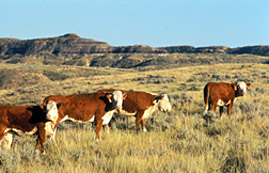This page has been archived and is being provided for reference purposes only. The page is no longer being updated, and therefore, links on the page may be invalid.
|
|
|
|
Mapping Prairie Grass Protein, Yield and Carbon
By Don ComisSeptember 26, 2007
A study by the Agricultural Research Service (ARS) and the University of North Dakota lays a foundation for eventually allowing ranchers to get Web-based information on the quality and quantity of forage plants in their fields. Ranchers could use this information to determine stocking rates, as well as how much carbon is stored in their forage plants.
Scientists Rebecca Phillips and Ofer Beeri have developed a way to measure rangeland forage plant yields in pounds per acre, and their quality in percent of protein content, over many acres. They’re using commercial HyMap hyperspectral imagery taken by airplane, which lets them capture images at more than 200 wavelengths—all of the light in the visible wavelength bands and invisible near-infrared and short-wave infrared wavelength bands.
Phillips is a plant physiologist at the ARS Northern Great Plains Research Laboratory in Mandan, N.D. Beeri is an assistant professor of space studies at the John D. Odegard School of Aerospace Sciences at the University of North Dakota in Grand Forks.
Phillips and Beeri used images of two 32,741-acre ecoregions on opposite sides of the Missouri River near the center of North Dakota, representing the Northwestern Glaciated Plains and the Northwestern Great Plains ecoregions. Although the regions are markedly different, the technique's accuracy across regions remained the same: 82 percent for yield predictions, and 92 percent for protein content.
The scientists were able to measure the quantity and protein content of both live and dead plant material, which often can’t be distinguished by conventional remote sensing. Dead grass and other plants are important in this part of the country, where cold weather hinders decomposition. Cattle get some protein out of dead grasses as well as live ones.
Using the images, Phillips and Beeri developed mathematical equations to estimate rangeland plant biomass. They also applied and validated a previously published algorithm for computing plants' carbon-nitrogen ratio. By combining the equations, they were able to compute and map the percent of protein in plant leaves over entire pastures of northern prairie grasslands.
Further research is needed to determine if the results apply in other regions of the country as well.
ARS is the U.S. Department of Agriculture's chief scientific research agency.

